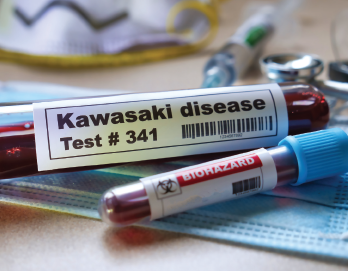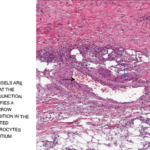The ACR, in concert with the Vasculitis Foundation, released three new vasculitis guidelines online first in July, with a fourth slated for publication by the end of the year. These are the first ever to be produced and endorsed by the ACR and the Vasculitis Foundation. Although most of the recommendations are conditional, due to the relative rarity of these conditions and correspondingly limited evidence base, these guidelines will provide clinicians with comprehensive information to help them make informed treatment choices with pediatric and adult vasculitis patients.
Needs & Challenges
Sharon Chung, MD, MAS, director of the vasculitis clinic at the University of California, San Francisco, served as the principal investigator of the overall vasculitis guideline effort. “In the past, we have essentially had prednisone and one other treatment for severe vasculitis—cyclophosphamide,” Dr. Chung points out. Other conventional immunosuppressive agents, such as methotrexate and azathioprine, have also been options for some vasculitides.
“More recently, we’ve had additional treatment options develop,” she adds. “Thus, the goal of the guidelines is twofold: to provide initial recommendations to rheumatologists and other care providers, as well as to provide guidance in choosing among the increasing options that we have.”
Given that newer biologic agents are now available, practitioners have had questions about how these different treatment options should be used in different clinical situations.

Dr. Langford
Carol Langford, MD, MHS, director of the Center for Vasculitis Care and Research at the Cleveland Clinic, Ohio, is one of the lead authors of the guideline focused on the management of anti-neutrophil cytoplasmic antibody (ANCA) associated vasculitis. She points out the ACR has targeted guideline development as an important initiative to both serve clinicians and improve patient care. “We had heard from a number of clinicians requesting that vasculitis guidelines be developed, given that these are uncommon diseases in which there can be complex therapeutic questions,” she says.
One of the inherent challenges of the project was its breadth. Vasculitis is a histopathological term indicating blood vessel inflammation, which can be seen in a wide variety of medical settings. “This is not like a guideline where you focus on one disease,” says Dr. Chung. “Many different diseases fall under the category of vasculitis, and many of them are treated very differently.” Many different disease entities are included, even if one is only considering the primary forms of vasculitis.
The manifestations can be quite different even within a specific disease. Dr. Chung provides the example of granulomatosis with polyangiitis (GPA): “There are patients with lung involvement, patients with kidney involvement, patients with sinus involvement. Thus, making recommendations for the group as a whole can be challenging, because certain therapies may benefit some more than others.”
A related challenge was the evidence base used to form the recommendations. Because of the rarity of these syndromes, it has been more difficult to conduct randomized, double-blind, controlled trials, limiting the availability of high-quality published evidence.
Guideline Development Process
In June 2017, the core leadership team formed by the ACR first met in person to begin the process of overseeing the vasculitis guideline development. The ACR also convened a voting panel, which would ultimately vote on proposed recommendations, and a separate expert panel to provide additional input, when needed.

Dr. Chung
Together, the core team and two panels, along with members of the literature review team tasked with assembling the evidence, determined the project’s scope. Explains Dr. Langford, “The first issue we had to tackle was how we were going to approach this. It wasn’t feasible to have a guideline for every single form of vasculitis, because the vast majority of these do have unique therapeutic approaches.”
For greater consistency with the existing literature, the team used the most recent nomenclature system for vasculitis, the 2012 Chapel Hill Consensus nomenclature. In this naming system, the forms of vasculitis are primarily characterized in terms of the predominant size of the affected blood vessel.1
The group opted to make guidelines covering seven different forms of vasculitis, grouped by vessel diameter size, “These are what we would consider the classic vasculitides that rheumatologists are most likely to encounter in their practice,” Dr. Chung adds.
All the final recommendations had at least 70% consensus from the voting panel.
Like previous recent ACR guidelines, the vasculitis guidelines were developed using the GRADE methodology (Grading of Recommendations Assessment, Development and Evaluation), a widely accepted systematic approach. This method provides clear interpretations for strong versus conditional recommendations based on the quality of available evidence and other factors, and it focuses on assessing specific, discreet management strategies.2
The core team and two panels next developed the questions that would be covered in the documents, with a standard PICO format used in previous ACR guidelines. Such questions clearly frame pertinent clinical questions in terms of the patient population, intervention, comparison and outcome(s) being examined in a specific clinical situation. Once these were developed for the selected guidelines, they were released for external commentary to the broader community.
After the group had revised these questions based on public comments, the literature review team began a systematic literature review. Ultimately, this involved evaluating 13,800 articles to identify the appropriate evidence to answer each PICO question.
Of these, the literature review panel ultimately selected 1,156 articles to address the 176 different PICO questions selected across the seven diseases. They used these data to compile a summary of the relevant articles used by the voting panel and also a separate patient panel, formed to provide input into the final recommendations.
Another of the core team members was Mark Gorelik, MD, an assistant professor in the Division of Pediatric Rheumatology, Allergy and Immunology at Columbia University Vagelos College of Physicians and Surgeons, New York City. He points out that guidelines are helpful for clinicians because they include an evidence summary of the existing literature.

Dr. Gorelik
Dr. Gorelik was one of the lead authors on the guideline focused on polyarteritis nodosa and the upcoming guideline article on Kawasaki disease. “Where rheumatologists might benefit most from these guidelines is the expert opinion on the context of the data,” he adds.
He provides an example drawn from Takayasu arteritis. “There is some evidence that tocilizumab is very promising for Takayasu arteritis. However, thus far, a careful review of the literature demonstrates that evidence of definite efficacy is not present. Therefore, the expert evaluation was that it is not at this time recommended for first-line treatment.”
After the evidence report was available, the patient panel was convened to give input on key questions relevant to care, such as patient preferences regarding medications. This panel comprised 11 individuals with different types of vasculitis, two of whom were also members of the voting panel. They conveyed the patient panel’s input during voting panel discussions about the final recommendations.
Next, the voting panel voted on each specific PICO question and gave it a strong or conditional recommendation. All the final recommendations had at least 70% consensus from the voting panel. The strength of the recommendation was determined by the quality of the evidence as well as by other factors, such as the expected severity of an outcome if a recommendation was not followed.
Very few of the recommendations put forth in the guidelines were given a strong recommendation, largely due to the limited evidence base. Dr. Langford notes the vasculitis community has worked together extremely effectively to develop collaborative, international networks that have allowed large-scale, randomized trials in a number of these diseases. “But particularly for some diseases, where that has really not been possible,” she says, “we looked at evidence based on well-done, open-label studies in conjunction with expert opinion.”
The guideline writers also made multiple ungraded position statements. Dr. Gorelik explains, “In these ungraded ones, it’s not that there aren’t enough data, but there is an equipoise in the literature or expert opinion; it doesn’t appear that intervention A or intervention B is any different.”
Dr. Chung notes the guideline developers want practitioners to know that both interventions could reasonably be considered. “These ungraded position statements address key topics, such as how long patients should be on medications. It was a way to provide some guidance to the practitioner instead of ignoring the question completely.”
Dr. Gorelik emphasizes that these guidelines provide the context of literature review and expertise to clinicians, but they are meant to allow physicians latitude to make their own choices (as part of shared decision making with patients). “They are guidelines, but the connotation of that can be a little bit prescriptive. We’re not intending that to be the case. An unintended result of overly prescriptive guidelines is to restrict patient access to certain treatments, and that is absolutely not what we want to do. We want everything to be available to everyone, if needed.”
‘Ungraded position statements address key topics, such as how long patients should be on medications. It was a way to provide some guidance to the practitioner instead of ignoring the question completely.’ … Dr. Chung notes the guideline developers want practitioners to know that both interventions could reasonably be considered.
For example, rheumatologists have sometimes used plasmapheresis in some vasculitis syndromes, especially in medically dire situations. The full picture is not completely certain yet, especially for specific patient subgroups. However, a large study published in 2020 showed plasmapheresis did not decrease the rate of death or end-stage renal disease in patients with severe ANCA-associated vasculitis.3
Dr. Gorelik explains this overall result and specific nuances needed to come across in the recommendations. For example, in patients with active glomerulonephritis and GPA or microscopic polyangiitis (MPA), the guidelines conditionally recommend against adding plasmapheresis to remission induction therapy for all patients. However, subsequent analysis by the literature review suggested patients at higher risk of poor outcomes may benefit. “We don’t want to draw a hard line, because maybe there are times when it is going to be necessary,” he notes.
Adds Dr. Langford, “Certainly the evidence basis is the foundation of how we provide guidance to our patients, but at the end of the day there are a number of individual situations that have to be weighed. Treatment history, contraindications to therapy and other patient-specific factors play an important role in deciding how to best apply these guidelines.”
Large Vessel Vasculitis Guidelines
Giant Cell Arteritis & Takayasu Arteritis

Bernard Chantal / shutterstock.com
The guideline for large vessel vasculitis provides separate recommendations for the management of giant cell arteritis (GCA) and Takayasu arteritis, two large vessel diseases with some similar clinical manifestations, with a total of 42 recommendations (almost all conditional) and three ungraded position statements. The recommendations include information about diagnostic strategies in these patients, use of specific pharmacologic agents and surgical interventions.
Dr. Chung points out that a recent trial (GiACTA) showing efficacy of tocilizumab in GCA has provoked debate about when exactly the drug should be utilized.4
Conditional recommendation: The guideline provides some context, such as conditionally recommending tocilizumab in addition to oral glucocorticoids over oral glucocorticoids alone in patients newly diagnosed with GCA (for tocilizumab’s steroid-sparing effect). However, glucocorticoids with methotrexate or glucocorticoids alone might be considered depending on multiple factors, such as the patient’s clinical situation and preferences.
This highlights a theme that emerged across all three vasculitis documents:
Recommendation: Minimize glucocorticoids when clinically feasible.
Although high-dose glucocorticoids have been the first drug of choice for many vasculitides, Dr. Chung notes, they pose significant toxicities for patients. “With the options that we are now identifying, we can use less prednisone for shorter periods of time with, hopefully, less toxicity. The identification of these steroid-sparing agents [such as tocilizumab in GCA] has really made that possible,” she adds.
Conditional recommendation: For patients with active Takayasu arteritis, use glucocorticoids plus a non-glucocorticoid immunosuppressive agent, such as methotrexate, instead of glucocorticoids alone, to minimize toxicity.
As another example, tapering from high-dose to low-dose glucocorticoids was conditionally recommended for patients who have been in remission for at least six to 12 months.
Another important section in this document is the use of imaging techniques for diagnosis and disease monitoring. “There have been significant advancements in imaging techniques for these diseases, so there has been the question of what imaging techniques we should use and how we should use them,” says Dr. Chung.
Conditional recommendation: The guidelines conditionally recommend temporal artery biopsy over temporal artery ultrasound for diagnosis of GCA.
For context, recent EULAR guidelines state that such a diagnosis can be made with temporal artery ultrasound or magnetic resonance imaging (MRI) of the cranial vessels without temporal artery biopsy.5 In contrast, the new ACR/VF guideline notes the limited professional expertise that operators in the U.S. have with these imaging modalities for these purposes at this time.
Medium Vessel Vasculitis Guidelines
Polyarteritis Nodosa
A second guideline provides recommendations for the management of patients who have systemic polyarteritis nodosa (PAN), a form of medium vessel vasculitis associated with severe morbidity. (Note: A guideline on Kawasaki disease is expected to be released later in 2021.)
The guideline provides 16 recommendations for PAN and an ungraded position statement. PAN associated with the hepatitis B virus and cutaneous PAN were both excluded from the guideline, because these are categorized separately within the 2012 Chapel Hill Consensus nomenclature.1 The recommendations include suggestions about diagnostic testing, treatment of active and refractory disease, and remission maintenance.
Dr. Gorelik points out that PAN is a rare disease that is becoming even more rare, because PAN secondary to hepatitis B has decreased since the introduction of the hepatitis vaccine. “The recommendations for PAN are based on very old and tried-and-true interventions, such as corticosteroids and cyclophosphamide,” says Dr. Gorelik. “Although there may be some utility in using biologics in PAN, because of the rarity of the syndrome, there is no evidence for these.”
Case reports have suggested that rituximab may be useful in PAN, but its efficacy remains unclear due to the lack of comparative or large, single-arm studies.
Conditional recommendation: Initiate treatment with glucocorticoids and cyclophosphamide over glucocorticoids with rituximab for newly diagnosed, severe PAN.
However, the guideline also recommends treatment strategies to reduce the use of glucocorticoids, when appropriate, as well as strategies to reduce cyclophosphamide, which also carries significant toxicities.
Conditional recommendation: In patients with newly diagnosed, active, non-severe PAN, use non-glucocorticoid immunosuppressive agents, such as azathioprine or methotrexate, over glucocorticoids alone to minimize glucocorticoid toxicity.
Small Vessel Vasculitis Guidelines
ANCA-Associated Vasculitis
The third guideline focuses on small vessel vasculitis, specifically a subcategory of those often positive for ANCA: GPA, MPA and eosinophilic granulomatosis with polyangiitis (EGPA).
“GPA and MPA have been examined together in a number of clinical trials,” explains Dr. Langford, “although there are some important strategies that are specific for GPA. EGPA has unique differences that impact therapy, so that was evaluated in a separate category.”
The group made 26 recommendations and five ungraded position statements for GPA and MPA, and 15 recommendations with five ungraded position statements for EGPA. Due to the lower quality of evidence, all recommendations were made on a conditional basis. The recommendations provide guidance relevant to initial treatment, maintenance therapy and adjunctive strategies for these diseases.
Dr. Langford explains how the panels approached many of these recommendations. “We looked at whether we are treating active disease and, if so, whether it is severe or non-severe. Once the person was out of that active phase, we examined the evidence for how to best maintain remission. It was really based upon how one would approach therapeutic questions that arise in clinical practice.”
As in the other vasculitis documents, the impact and role of glucocorticoids was kept in mind. “Glucocorticoids are probably some of the most difficult therapies for our patients in terms of their side effects and how they affect their quality of life,” Dr. Langford notes. “An important area of investigation has been examining ways of minimizing their toxicity and reducing the need for glucocorticoids.”
In terms of biologics, of note is a conditional recommendation for mepolizumab, in addition to glucocorticoids, for non-severe EGPA, although cyclophosphamide or rituximab is recommended for remission induction in patients with severe disease.
The guideline also conditionally recommends the use of rituximab over cyclophosphamide for remission induction in patients with severe, active GPA or MPA, as well as its use during maintenance therapy, over methotrexate or azathioprine, in patients with severe disease.
Dr. Chung puts these guidelines in the context of the recent consensus treatment plan for severe pediatric ANCA-associated vasculitis released by the Childhood Arthritis and Rheumatology Research Alliance (CARRA).6 The CARRA goal was not to develop guidelines per se, but to recommend potential treatment plans to better enable future study of comparative effectiveness and safety.
“Overall, the consensus treatment plans presented by CARRA align with the treatment options presented in the ANCA-associated vasculitis guidelines,” notes
Dr. Chung.
For example, the ACR-VF guidelines’ conditional recommendations of rituximab over cyclophosphamide for remission induction and rituximab over methotrexate or azathioprine for remission maintenance are, in part, due to the guideline team’s experience with these treatment regimens in adults. However, given the lower amount of evidence in pediatric patients, it is reasonable to use either option in this population, per CARRA’s treatment plans, and ultimately collect data that can support stronger recommendations for this group in the future.
Identifying Knowledge Gaps
As much as guidelines highlight existing knowledge, guideline creation also shines a spotlight on areas where knowledge is lacking. The guidelines provide information about areas for future research, but some questions will remain challenging to study, given the rarity of these diseases.
“I think research on biologics in PAN would be wonderful if it could be done,” Dr. Gorelik says, “because it could spare patients high doses of steroids and cyclophosphamide. But that would require either a very large-scale effort to collect all the patients or somehow to model the disease in a basic science manner.”
Dr. Langford notes that with current therapeutic options, vasculitis has become a treatable yet chronic disease in many patients. “One of the main questions our patients [ask] is how long they need to be on a maintenance treatment,” she says. “Through ongoing research, the identification of biomarkers may help us identify which treatment to use in which patients and for how long.”
Other studies may provide important translational insights that would allow us to develop better therapies. Ideally, we could identify new agents—or agents repurposed from other applications—that may reduce toxicity. Head-to-head trials could give us information about how to best use the available medications. Long-term studies could help us better understand disease course and the safety of current therapies.
For the present, rheumatologists will have to rely on expert insight informed by the current medical literature to help them make these choices.
“This has been a Herculean effort, given the number of diseases, the number of clinical questions and the sheer amount of evidence that has been reviewed,” says Dr. Chung. “I am sure that over the years these guidelines will be revisited and revised as new information comes in, but this is an initial effort to provide guidance to clinicians on these issues.”
Ruth Jessen Hickman, MD, is a graduate of the Indiana University School of Medicine. She is a freelance medical and science writer living in Bloomington, Ind.
Vasculitis Awareness Month May 2021
Learn more: https://www.vasculitisfoundation.org/vam-2021-landing
References
- Jennette JC. Overview of the 2012 revised International Chapel Hill Consensus Conference nomenclature of vasculitides. Clin Exp Nephrol. 2013 Oct;17(5):603–606.
- Perel P. The GRADE methodology for guideline development. Rheumatology. 2014;53(suppl 2):i9-i10.
- Walsh M, Merkel PA, Peh CA, et al. Plasma exchange and glucocorticoids in severe ANCA-associated vasculitis. N Engl J Med. 2020 Feb 13;382(7):622–631.
- Stone JH, Tuckwell K, Dimonaco S, et al. Trial of tocilizumab in giant-cell arteritis. N Engl J Med. 2017 Jul 27;377(4):317–328.
- Dejaco C, Ramiro S, Duftner C, et al. EULAR recommendations for the use of imaging in large vessel vasculitis in clinical practice. Ann Rheum Dis. 2018 May;
77(5):636–643. - Morishita KA, Wagner-Weiner L, et al. Consensus treatment plans for severe pediatric antineutrophil cytoplasmic antibody-associated vasculitis. Arthritis Care Res (Hoboken). 2021 Mar 6. [Online ahead of print.]
Updated Aug. 3, 2021, with the guideline release information.



